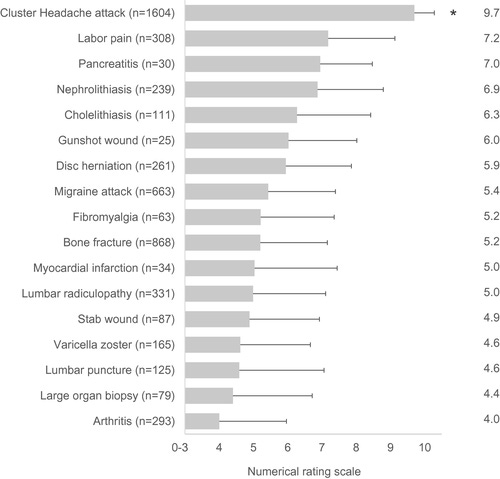This post is from the ‘Showing My Workings’ section: Lil bits and pieces from what I've been doing or thinking about, that aren't complete or meaty enough to post to main blog. If you don’t want to get ‘Showing My Workings’ posts emailed to you, just click unsubscribe down the bottom of this email and then, on the page that comes up, to the right of ‘Showing My Workings’ click the ‘stop getting emails’ button.
For a study published in 20201, researchers surveyed 1604 people who suffer from cluster headaches, a specific type of headache which is worse than migraines. The 1604 people were asked to rate cluster headache painfulness on a 0-10 scale, and to also rate other experiences from a list on a 0-10 scale, if they had personally experienced those experiences. This gives some really interesting data as we can see what experiences hurt more or less compared to each other, according to people who’ve personally experienced them and have a common reference point they’ve also personally experienced (cluster headaches). The graph above shows the results, which I find fascinating (as well as pretty horrifying when you think about the magnitude of the suffering).
The first thing that jumps out is just how much more painful people say cluster headaches are than anything else on the list, including stab wounds, gunshots, labour, migraines. And remember this is according to people who have personally experienced both. Beyond that, seeing the comparisons between all the other experiences is really interesting to me as well and quite surprising. For example, I would not have expected stab wounds to be so far down the list! And I I knew labor was super painful, but I think I was still underestimating how painful it is compared to all of these other things.
Of course all studies have limitations or potential issues, and some of the limitations I can see with this study are: Of course most or all people wouldn’t have personally experienced all these experiences (god forbid), and so they aren’t necessarily actually directly comparing e.g. stab wound painfulness to fibromyalgia painfulness (though they are all rating them alongside cluster headaches, which they have all experienced, so at least they all have a common reference point). Seems to me this could also potentially mean that if having certain experiences is correlated with some other variable (e.g. if men are more likely to experience a gunshot wound), and if that other variable is correlated with how people rate pain (e.g. if men on average rate pain higher or lower), then that could distort the results. They also didn’t ask people about or take into account what pain medications people did or didn’t receive with any of these experiences (e.g. epidural during labour), which obviously could effect how painful people rate them. Though it’s hard to know whether people would be trying to adjust for this themselves in their answers (e.g. “Oh that didn’t hurt so much once I got the pain meds, but I assume they want to know the raw pain of the experience so I’ll rate on how painful it was before I got the meds.”)
In Logarithmic Scales of Pleasure and Pain, Andrés Gómez Emilsson argues that pain scales like this are actually on a logarithmic, not linear, scale. This would mean basically that when someone jumps from saying ‘3’ to saying ‘4’ in pain, that would correspond to a larger actual pain increase than the jump from ‘2’ to ‘3’ does, and ‘4’ to ‘5’ would correspond to an even larger increase and so on, even though these jumps are all 1 point jumps on the scale. This logarithmic scales idea matches how one scale of specifically cluster headache intensity, the KIP scale, is used, according to this cluster headaches website. This idea of logarithmic pain scales has not reached scientific consensus (as far as I know) (I’m not sure if there is a consensus view on this), but if it is true it could imply that the true comparison between these experiences could look something more like this (very handwavy, see footnote)2:
Fucked up.
Mark J. Burish et al., ‘Cluster Headache Is One of the Most Intensely Painful Human Conditions: Results from the International Cluster Headache Questionnaire’, Headache, 2020, https://www.semanticscholar.org/paper/Cluster-headache-is-one-of-the-most-intensely-human-Burish-Pearson/3025896ec2df1bfc594b7eb7b18c99a35f091549.
Using the exponential scale from the clusterbusters pain tracker, which they don’t really ake clear how they derived, so this is all pretty handwavy. I also can’t actually see a place they’ve clearly described specifically how the ‘intensity factor’ is exponential in their scale, they just say that a “KIP 10 is not just twice as bad as a KIP 5, it’s ten times as intense.” so I’ve just gone off that and so used a base of 1.585 for the exponential because 1.585^10 is roughly ten times 1.585^5 . If you know of a place this scale is more clearly described please let me know.





